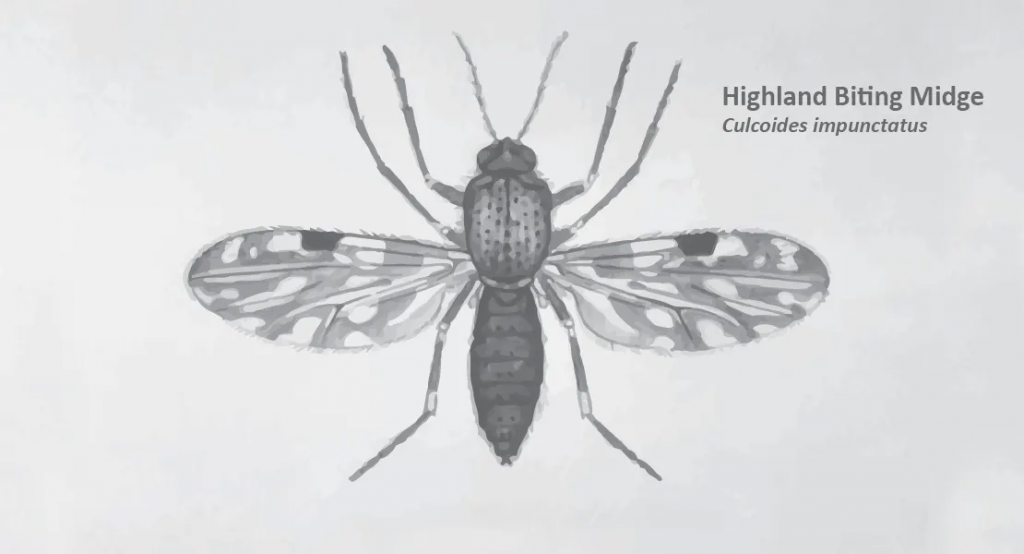The humble midge can be the bane of people living in Scotland, particularly in the Scottish Highlands and the west coast, but we do get them in east Scotland, too, just in lesser concentrations.

Although there is a running joke about midges being a major predator in Scotland, they do actually influence tourism and the local economy affecting camping trips, fishing, and hiking, as well as people who work outside, such as rangers, gardeners and farmers. People will even take entire days off work if the midge season is particularly bad… the tourist industry loses out on hundreds of millions of pounds in lost revenue every year due to midges, with tourists wisely staying away at peak times.
Biting midges are not pleasant and should be taken seriously if you are planning a trip to the Scottish Highlands or the west coast and associated islands.
Let’s have a deep dive into the midge scourge and see if we can mitigate any problems you may encounter on your visit to Scotland.
What are Scottish Midges/Midgies?
The Highland biting midge is a small flying insect that appears in the spring and summer months. All areas of Scotland are affected, but the worst areas are in the west highlands due to perfect breeding grounds in the wet conditions. Scotland’s Midges are only between 1-3 mm long and a light grey colour unless they have a belly full of blood; then, disgustingly, they might look red.
Midges in Scotland are in the family of Ceratopogonidae and are named “Culcoides impunctatus” scientifically. The Gaelic name for midge is “meanbh-chuileag”, which means “pigmy fly” or “tiny”. Females lay eggs in the wet soil or vegetation, which then hatch into larvae in less than 24 hours. Female midges do not need a blood meal to lay their first batch of eggs after mating with male midges. To reproduce again, midges will require an abdomen full of blood to lay each additional batch of eggs (usually a maximum of three batches in their lifetime). In midge season, there are potentially 180 trillion midges in Scotland!
The female midge has powerful serrated mandibles, perfect for biting into the skin and will source their blood meal from any available animal within their vicinity, from cows, sheep, horses/ponies to humans; they are not fussy eaters! They are also drawn to flowers and sap but will prefer a live blood feast.
Cold weather and frost, in particular, are the death knell for the Scottish midge; they cannot survive cold weather conditions much to the relief of the west coast population. The soil-dwelling larvae will hunker down over the winter, ready to restart the process again next year. Amazingly a bad winter does not seem to affect the following year’s swarm, and numbers can actually increase.
In my area of northeast Scotland, these tiny flying insects are called midgies (midgees); I guess this is yet another local difference in the pronunciation of some words.
How long do midges live?
20-30 days is the average lifespan.
They aren’t too bad, more of an itchy annoyance, but many bites may cause significant discomfort. The midge will actually feed for 3 to 4 minutes until they have had its fill of blood, and you may not even feel it. The midge bite injects anticoagulant saliva into the wound, the body’s reaction to this is to create itching/swelling, and this is why the raised red bumps appear on the skin. Only female midges bite.
Discover more from WILLIAMS WRITINGS
Subscribe to get the latest posts sent to your email.


Thanks for the heads up. I now know when to avoid Scotland!
Scotland is such a beautiful country
lol, thanks a lot guys appreciate your time and visits.
Although infamous, the Midge impress Scotland more on visitors: Once stung, twice recollected.
Ooh, they remind me of the black flies in the Adirondacks back East. Little tiny buggers that land on you (often in your hair) take a chunk out of your skin, have a nice little drink, and then fly away, and you only find out about it when you scratch your head and your fingers come away bloody. They’re found near streams and running water and since the entire Adirondacks is full of streams and running water the little bastards are just about everywhere …
yep they must be the midges cousins lol because thats exactly what they do, so annoying, thanks James, hope your having a nice day.